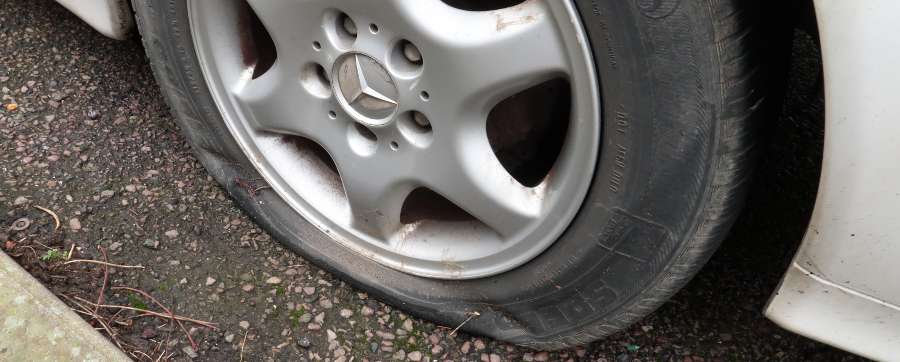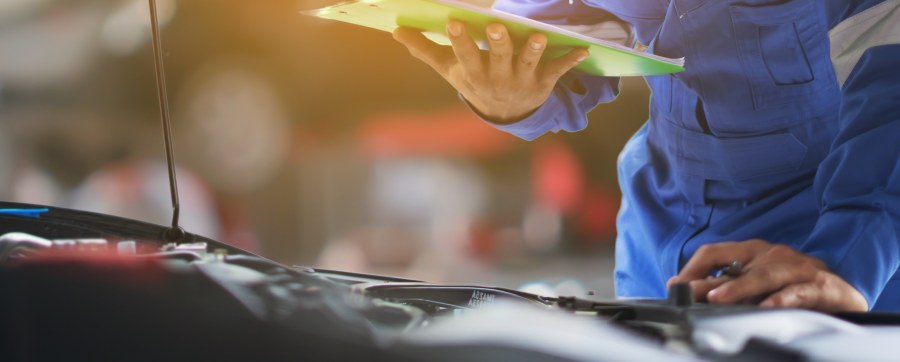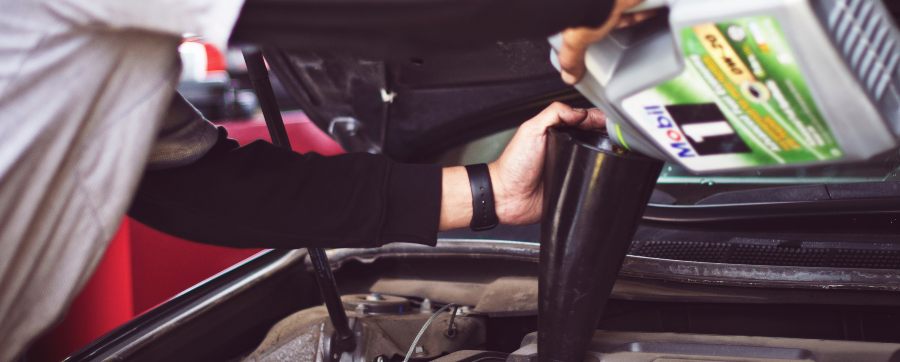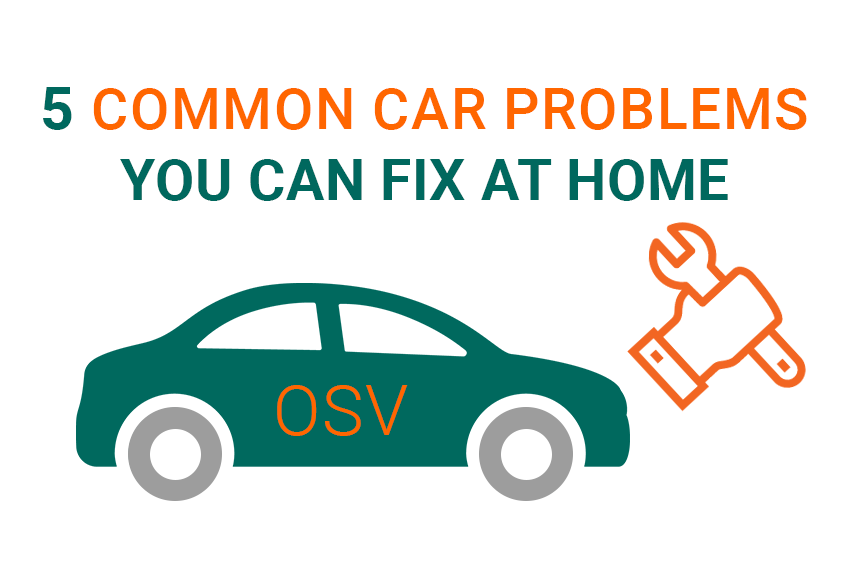Do you ever hear your car make a weird noise? Wish you knew what it was? What about a time when your car didn’t feel quite right? Have you ever wished you just had that little bit of extra knowledge about common car faults so you could know what was wrong without having to take it to a garage?
We’ve all been there. And we’ve also been at the garage hearing a mechanic tells us the very simple problem with the car that only takes five minutes to fix. If only you knew more about the most common car problems, and how to fix them.
Well, cringe at your lack of car knowledge no longer. In this article, we look at some of the most common car problems people have and the best way to fix them.

Most common car problems
So, you know your car will at some point run into problems. You also know you’ll need to learn the best ways of taking care of your vehicle yourself. But what exactly are some of the most common car problems? Here are some of them:
- Flat tyre
- Flat car battery
- Blown lightbulb
- Faulty spark plugs
- Low oil levels
Keep on reading to discover the best ways to take care of some of the most common car problems.

How do you change a flat tyre?
Everyone should be able to fix a flat tyre and the chances are you do know how to fix this common car problem. However, it’s always good to refresh your memory. Fixing a flat tyre is pretty easy, and here’s how you do it;
- Use a car jack on a stable part of the frame to hoist the vehicle upwards
- Remove the lug nuts using a locking wheel nut and ratchet
- Put the spare tyre on
- Tighten the nuts
- Bring down the jack
For a visual guide on how to change a flat tyre, watch a quick video here.

How do you fix a flat car battery?
You’ll definitely know if your battery is dead because your car just won’t start. This is where preparation comes in as it’s a good idea to keep a spare pair of jump leads in your car in case this happens. Alternatively, having a car battery charger in your garage is also a good idea.
If your car battery hasn’t completely discharged, you can charge it back up with a car battery charger as we mentioned above. This simply plugs into the mains.
However, if your battery is completely flat, then charging it up won’t work. Instead, you can try and jump-start the car using jump leads and a ‘donor’ car. If you don’t have a second car to jump-start the battery, you can use a power pack.
Before you try and jump start your car, you need to check the battery. If it is leaking, corroded or damaged then DO NOT try and jump-start it. Call someone out to have a look over the battery.
Keep all metal objects away from the car and don’t have any naked flames (no smoking either). Remove the key from the ignition and make sure everything is off, and keep loose clothing away from the battery as well.

Now, here’s how you jump start a car;
- Park both the cars next to each other – not touching but close enough so the jump leads can reach both vehicles
- Open the bonnet and connect the first end of the red positive lead to the positive terminal of the battery that works (in the donor car)
- Do the same for the other end for the flat battery
- Connect the black negative lead to the negative terminal on the working battery
- Attach the other end to a metal point (a bracket, for example) away from the flat battery
- Your car may have a negative jump-starting pole so refer to your handbook in this case
- Check the leads are away from all moving parts
- Start the engine of the working car
- Leave it for about a minute, and then try and turn on the car with the flat battery
- If it doesn’t turn on, leave it for a few more minutes but if the leads get hot then you should turn the engine off
- Once the car with the dead battery is running then you need to leave it running for a couple of minutes to charge the battery
- Remove the jump leads in the reverse way you attached them
- Ensure that they don’t touch each other or any other metal surface
You will need to either keep your car running or drive for at least thirty minutes after your car has been jump-started. If this doesn’t work, then you will have to call someone out.
Please only try jump-starting a car if you feel comfortable doing so and know what you are doing. If you are in doubt, don’t try it.
Also, it’s worth noting that if you do successfully jump start your car or recharge your battery then your car battery might be shortened significantly. So, if this does happen then you should look into getting your car battery replaced anyway.

How do you replace a lightbulb?
You might have discovered this at a very inopportune time, most likely when other drivers start flashing you like mad and you don’t know why.
Bulbs in your car go every now and again, just like a lightbulb in your house. And, like lightbulbs in your house, they are fairly easy to replace.
You will have to make sure that you buy the right bulb, you can check this by looking at your handbook. You will also have to refer to this to find out how to access your lights. Some cars might have plastic coverings, and others will have lights that simply pop out.
Once you have worked that out, you will have to make sure your car is turned off before you unplug the bulb. Then you simply attach the new bulb, replace the cover and check that it’s working.
It’s as simple as that. You can get bulbs from your local car parts supplier or online. Halfords allow you to search for bulbs by entering your car details to ensure that you don’t order the wrong ones.
How can you fix faulty spark plugs?
If you are having difficulty starting your car or it sounds a bit off when idling, then your spark plugs may be faulty.
Again, this is relatively easy to fix once you know how. Firstly, you have to buy a new set of spark plugs, these are fairly cheap to replace, but you will have to make sure they are right for your car.
Once you have those, here’s how you replace them;
- Open the bonnet
- Remove any HT leads and other obstacles that may obstruct access to the spark plugs
- Brush away any dirt from around the spark plugs
- Unscrew them with a spark plug socket spanner and remove them
- Use the feeler blades or gap setting tool to check the electrode gap of the new plugs
- You should refer to your vehicle manual for this to see if it’s applicable
- Put some copper grease on the threads of each of the new plugs and screw them in
- You will then need to tighten them with a torque wrench
- You will need to check your handbook to check the correct torque
- You will have to reconnect the HT leads and put back in any other parts you may have removed
And that’s it. You can watch a video on how to change your spark plugs here.
Changing your oil
This isn’t so much a car problem, but car maintenance. That said, you can have some serious problems if your oil levels get too low so prevention is key when it comes to oil levels.
If your oil levels get too low the engine will overheat and that increased friction can cause permanent damage.
It is advised that you check your oil levels every two weeks. You can do this by finding the handle labelled “Engine Oil”.
Then you remove the oil dipstick, clean it and place it back into the pipe. You will then remove it once more and check where the oil film comes up to. It’s that simple.

If you have found that your oil levels are too low, then you can replace this quite easily. Here’s how you do it;
- Find your vehicle’s oil pan
- Unscrew the drain plug and drain the old oil into the pan
- Replace the drain plug
- You will remove the oil filter using your oil filter wrench
- Then lubricate the rubber gasket on the new oil filter using new motor oil
- Fill the new oil filter about two-thirds of the way
- You will then screw in the new oil filter
- Fill the engine with the new oil
- Double-check the oil levels
- And then you will need to dispose of the old oil filter and the old oil
You can recycle your old oil at an oil bank. You can locate your nearest oil bank here, there are probably more local to you than you think.
And that’s how you replace your oil. Be aware that it can be messy work and can be a bit fiddly. Only change your oil if you are completely comfortable doing so. For more information on how to take care of your car read our article about car maintenance.
So there are some of the common car problems and how to fix them. These are the most common and the most simple to fix. That said, if you are unsure about any of what we have written about then we do recommend you pop into your local garage.
Only fix your car yourself if you feel comfortable doing so and you think that you will be able to do it safely. Hopefully, though, this has explained how to fix some of the most common car problems.



I really didn’t know these tips before which you have informed us through your helpful and informative article!! Thank you and keep sharing awesome stuff.